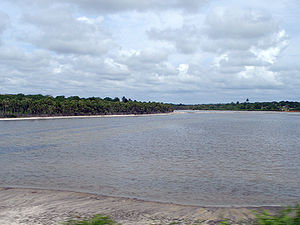Conquest of Paraíba
This article relies largely or entirely on a single source. (August 2023) |
| Conquest of Paraíba | |||||||
|---|---|---|---|---|---|---|---|
| Part of the Dutch invasions of Brazil | |||||||
 Jaguaribe River, in the vicinity of Aracati | |||||||
| |||||||
| Belligerents | |||||||
|
| |||||||
| Commanders and leaders | |||||||
|
|
| ||||||
| Strength | |||||||
| Unknown |
21 ships 11 yachts | ||||||
| Casualties and losses | |||||||
| Unknown | 82 dead, 102 wounded | ||||||
The Conquest of Paraíba refers to the attempts by Dutch forces in 1630 to seize control of Paraíba, Brazil, from the Portuguese, mainly for the lucrative sugar cane market.
Details
[edit]After conquering Recife, Lichthart decided to set sail for Paraíba. In December, Lichthart led an expedition towards Paraíba with a fleet comprising 21 ships and 11 yachts, organized into two separate squadrons. The expedition reached the Jaguaribe River, the easternmost point of Brazil, on December 3. Upon arrival, they immediately deployed 600 soldiers due to an encounter with Portuguese forces. After their initial victory, reinforcements under Gaspar van der Ley arrived, and they proceeded southward along the peninsula of the Paraíba River, where they laid siege to the well-fortified Fort Santa Catarina do Cabelo. During the siege, the commander of the garrison, João de Mattos Cardoso, passed away, prompting the Dutch forces to appoint a replacement who also died just one day after taking charge. After two weeks of siege, the fort finally surrendered to the Dutch. The Dutch only having 82 dead, and 102 wounded, invaded Fort São Felipe and the regional capital, Filipeia de Nossa Senhora das Nevoas (known today as João Pessoa). Subsequently, they captured other nearby forts, and one of them, Fort Cabedelo, was renamed Frederiksdorp in honor of the Dutch Stadtholder, Frederik Hendrik, the Prince of Orange.[1]
References
[edit]- ^ Marley, David (2008). Wars of the Americas A Chronology of Armed Conflict in the Western Hemisphere (e-book ed.). ABC-CLIO. p. 190. ISBN 9781598841015.
